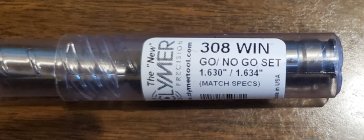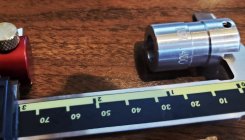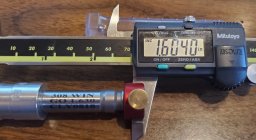If 6 thou sloop was enough to cause fail to fire wouldn't all factory loaded ammo fail. Of course it doesn't. I never measured an unfired factory case and compared to a fired case with a bump gauge. Whatever the dimensions are factory ammo is a very loose fit in the chamber. None of this is complicated why all the post and replies. Don't see why you need to compare with a no/go gauge. A fired case is your standard to compare to.Most likely it's your annealing doing that.
6 thou excess is enough to cause ftf.
I would stop annealing for the time being. Even though I'll get roasted for saying this, it's overrated. It's just another variable that can be wrong very easily.
You are using an out of date browser. It may not display this or other websites correctly.
You should upgrade or use an alternative browser.
You should upgrade or use an alternative browser.
Shoulder bump, how much is too much ?
- Thread starter Jeff Porter
- Start date
I understand. However, my f-class fireform load will shoot within a few points of my normal match loads, so I will fireform at a club match. The biggest difference is that the velocity is around 100 fps lower. Nothing is 'wasted'.It’s not worth the primer powder and bullet to save the brass by jamming and fire forming. Those components are more valuable in new brass. Not to mention my time has some value.
urbanrifleman
Site $$ Sponsor
If 6 thou sloop was enough to cause fail to fire wouldn't all factory loaded ammo fail. Of course it doesn't. I never measured an unfired factory case and compared to a fired case with a bump gauge. Whatever the dimensions are factory ammo is a very loose fit in the chamber. None of this is complicated why all the post and replies. Don't see why you need to compare with a no/go gauge. A fired case is your standard to compare to.
"excess".
Especially with hard primers and small firing pins.
urbanrifleman
Site $$ Sponsor
I understand. However, my f-class fireform load will shoot within a few points of my normal match loads, so I will fireform at a club match. The biggest difference is that the velocity is around 100 fps lower. Nothing is 'wasted'.
Was shooing some 22br brass that a customer sent me on a trade. The shoulders are 6 thou shorter than Lapua brass. They absolutely will not go off in a standard 22bra with a small firing pin and hard primers. So, I jammed the bullets 40 thou. I am here to tell you those 88 ELDMs go into teeny tiny little holes jammed like crazy. Those long 22 bullets love LOTs of jam.
Coyotefurharvester
Silver $$ Contributor
Jeff, I have went to an ammo checker to give me 1st case out of the die visible/measureable evidence that my die/shell holder is correct. For the 223(I have several gas/bolt guns) this results in brass that works in all of them. No ftf or case head separation issues.
I do it roughly the same.Here's what I do. (Bolt rifles only)
Using virgin cases after once fired, I do not bump the shoulders. I set the F/L die to zero bump (without extruding the case) for the case with the longest case headspace assuming this case chambers without issue and those always do with my rifles. Eventually after a few firings all the cases develop a relatively uniform case head space.
Often, I can go several cycles before I have to bump the shoulders. I believe the reason is that the F/L die also sizes the radial dimension of the case and often that is all that is necessary for several cycles. Bumping is a corrective procedure to restore, if needed, chambering.
Using a quality bump gauge and caliper you can easily monitor case head space, and it will tell you when you need to bump the shoulder along with a quick check in the rifle chamber.
As someone else mentioned, measuring cases with a bump gauge requires some experience and technique to obtain consistent results. Have you tested your technique by repeated measurement of some sample cases?
I have seen errors with the Hornaday tool because if you don't match up the insert with the gauge holder and caliper the same every time, you can obtain inconsistent results, granted only a few thousands but that is still undesirable. For this reason, I used the Whidden single piece, caliber group specific bump gauge permanently mounted on a dedicated caliber. This significantly increased consistency of my measurements.
When I first started reloading I got a lot of variation, and it was inconsistent pressure at the bottom of the stroke. I just sort of let it cam over on its own now. Same with bullet seating.
I haven't noticed anything related to brand. Starline 556 same result as other brands. It does seem the amp annealer improved it a little.
Jeff Porter
Gold $$ Contributor
Factory ammo comes sized to SAAMI min spec. which is the Go Gauge length. Using a case gauge like one of these, you will get values of 0.000 plus or minus 0.001" on factory ammo that I have checked.If 6 thou sloop was enough to cause fail to fire wouldn't all factory loaded ammo fail. Of course it doesn't. I never measured an unfired factory case and compared to a fired case with a bump gauge. Whatever the dimensions are factory ammo is a very loose fit in the chamber. None of this is complicated why all the post and replies. Don't see why you need to compare with a no/go gauge. A fired case is your standard to compare to.
My brass was sized more than 0.003" and up to 0.010" under that number while my target was to just kiss the shoulder and have 0.001" bump to square up the case.
I used the Go gauge to verify my tools and my technique were giving me valid results. Fired case is the standard.
Last edited:
I read on this website that the manufactorers of go/no gauges don't all make them to the same dimensions. +/_ 1 or 2 thou???Factory ammo comes sized to SAAMI min spec. which is the Go Gauge length. Using a case gauge like one of these, you will get values of 0.000 plus or minus 0.001" on factory ammo that I have checked.
My brass was sized more than 0.003" and up to 0.010" under that number while my target was to just kiss the shoulder and have 0.001" bump to square up the case.
I used the Go gauge to verify my tools and my technique were giving me valid results. Fired case is the standard.
CharlieNC
Gold $$ Contributor
Dwell time or pulling the handle down twice provides better consistency. The primary question is what is the "zero" head space dimension from which you should bump? This can be easily determined by partially seating a primer such that it protudes slightly, chamber it, close the bolt to complete the seating. Measure HS and bump from this.
The post about dry firing reducing headspace on the brass case, is this even a possibility of happening?
I spin the case 180 and size it again usually, overkill maybe-maybe not.Dwell time or pulling the handle down twice provides better consistency. The primary question is what is the "zero" head space dimension from which you should bump? This can be easily determined by partially seating a primer such that it protudes slightly, chamber it, close the bolt to complete the seating. Measure HS and bump from this.
6.5 forever
Silver $$ Contributor
This a good suggestion. I clean my Whidden days. But I don't do it consistently.Knowing you and how particular you are, you've likely already checked this, but maybe do a deep clean of the sizing die. There just may be a buildup of lube causing the variation of setback.
Monte F
Silver $$ Contributor
On my last batch of Starline 308 match SRP brass, I had several ftf with my normal .015" jump. Had to reseat the bullets for a hard jam to get them to fire and form to the chamber. When I measured those that did not fire the first time, they were all several thousand short when checking with my RCBS case micrometer. Two of them I had to use new primers as the first ones just would not fire after repeated tries.
I have another 150 pieces arriving tomorrow and plan on seating long on the first firing to get them to ignite reliably. I am going to check a few to see what length they come new. Only had this problem on the last batch and may not have it on this next batch.
I have another 150 pieces arriving tomorrow and plan on seating long on the first firing to get them to ignite reliably. I am going to check a few to see what length they come new. Only had this problem on the last batch and may not have it on this next batch.
When I got my .308 SRP brass last year, I took shoulder datum measurements of that virgin brass and got measurements at 1.6030 - 1.6040. After firing the batch of 100, the measurements were 1.6020 to 1.6030. As a reference for those measurements, when I measure my Go Gauge that was used to mount the barrel, which states its measurement as 1.630", myOn my last batch of Starline 308 match SRP brass, I had several ftf with my normal .015" jump. Had to reseat the bullets for a hard jam to get them to fire and form to the chamber. When I measured those that did not fire the first time, they were all several thousand short when checking with my RCBS case micrometer. Two of them I had to use new primers as the first ones just would not fire after repeated tries.
I have another 150 pieces arriving tomorrow and plan on seating long on the first firing to get them to ignite reliably. I am going to check a few to see what length they come new. Only had this problem on the last batch and may not have it on this next batch.
It'd be interesting to know what your difference between your virgin brass measurement and the fired brass measurement.
Last edited:
Curious about your Hornady comparator. Using the D400 insert, I getWhen I got my .308 SRP brass last year, I took shoulder datum measurements of that virgin brass and got measurements at 1.6030 - 1.6040. After firing the batch of 100, the measurements were 1.6020 to 1.6030. As a reference for those measurements, when I measure my Go Gauge that was used to mount the barrel, which states its measurement as 1.630", my Hornady headspace comparator I measured 1.604". These cases were loaded with Rem 7 1/2 primers and the 168 SMK used were .016" off the lands. I had no chambering issues and no ignition issues for any of the 100 cartridges.
It'd be interesting to know what your difference between your virgin brass measurement and the fired brass measurement.
1.630 gauge measures 1.630
Current barrel, fireformed brass 1.632
New Lapua 1.624
Size to 1.628 and, using a Sac bushing with taper, get a slight "feel" closing bolt.
If you get a little bolt lift resistance after you pull the trigger, you’ll likely need another thousandth of sizing.Curious about your Hornady comparator. Using the D400 insert, I get
1.630 gauge measures 1.630
Current barrel, fireformed brass 1.632
New Lapua 1.624
Size to 1.628 and, using a Sac bushing with taper, get a slight "feel" closing bolt.
Ah Ha . . . I forgot I don't use my Hornady comparator for head space any more.Curious about your Hornady comparator. Using the D400 insert, I get
1.630 gauge measures 1.630
Current barrel, fireformed brass 1.632
New Lapua 1.624
Size to 1.628 and, using a Sac bushing with taper, get a slight "feel" closing bolt.
But, I do have a Hornady headspace comparator D400 that I haven't used in years and here's how it measures my Go-Gauge:

. . . and my .308 virgin Lapua brass measures .003" less (1.6185").
Here's the Go / N0 Go set that I use:

My Whidden Gunworks comparator:


All these difference is why they're "comparators"
Last edited:
Monte F
Silver $$ Contributor
I do not remember the specific numbers as this was about two years ago. When I measure the fired brass I have it is about 1.634-1.635" using my RCBS micrometer case gauge. I get this from measuring my go gauge (1.630") in the micrometer gauge and the difference I get with the fired brass.When I got my .308 SRP brass last year, I took shoulder datum measurements of that virgin brass and got measurements at 1.6030 - 1.6040. After firing the batch of 100, the measurements were 1.6020 to 1.6030. As a reference for those measurements, when I measure my Go Gauge that was used to mount the barrel, which states its measurement as 1.630", myHornadyWhidden Gunworks headspace comparator I measured 1.604". These cases were loaded with Rem 7 1/2 primers and the 168 SMK used were .016" off the lands. I had no chambering issues and no ignition issues for any of the 100 cartridges.
It'd be interesting to know what your difference between your virgin brass measurement and the fired brass measurement.
The new virgin batch I received today measure right at 1.630" on 9 of 10 with one about a thousand under. If I recall correctly the ones that had ftf two years ago were around 5 thousands under size, maybe a little more. I think I will still jam these just to be sure I get good firings the first time out, or if I measure all 150 only the short ones.
Upgrades & Donations
This Forum's expenses are primarily paid by member contributions. You can upgrade your Forum membership in seconds. Gold and Silver members get unlimited FREE classifieds for one year. Gold members can upload custom avatars.

Click Upgrade Membership Button ABOVE to get Gold or Silver Status.
You can also donate any amount, large or small, with the button below. Include your Forum Name in the PayPal Notes field.
To DONATE by CHECK, or make a recurring donation, CLICK HERE to learn how.

Click Upgrade Membership Button ABOVE to get Gold or Silver Status.
You can also donate any amount, large or small, with the button below. Include your Forum Name in the PayPal Notes field.
To DONATE by CHECK, or make a recurring donation, CLICK HERE to learn how.









